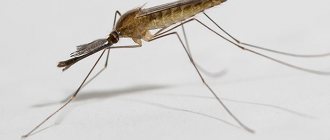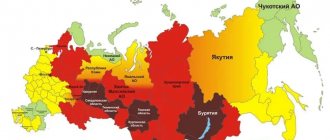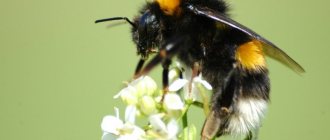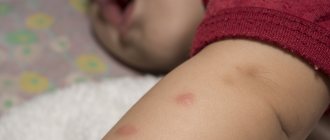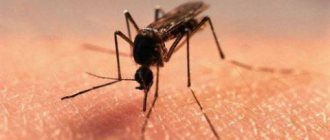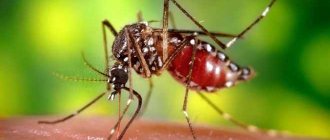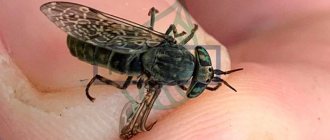Our article will tell you what a malaria mosquito looks like, how it differs from a regular one, and will also give recommendations that will help you avoid complications after a bite. 7771111
Until recently, people associated the malaria mosquito with hot tropical countries with very high humidity. Until a certain period, this was the case, but due to global warming and rising temperatures on our planet, this unpleasant buzzing insect began to feel great almost everywhere.
To be more precise, the malaria mosquito can live anywhere where there are no long winters. And since this insect can harm human health, we want to introduce you to it in more detail and tell you how to prevent unpleasant consequences from a malaria mosquito bite.
What does a malaria mosquito look like, where does it live, and how does it differ from an ordinary mosquito?
External differences between a malaria mosquito and an ordinary mosquito
Most people have little understanding of the types of mosquitoes, so it is quite difficult for them to distinguish an anomaly mosquito from an ordinary one. But still, if a person is very attentive, he can easily understand whether a buzzing insect poses a danger to his health. The most noticeable difference is the size of the insect .
As a rule, even the youngest malaria mosquitoes are about 2 times larger than those that live in forests, swamps and parks. The second difference is the size of the legs . They are also longer than those of a regular mosquito. Due to the size of the legs, the insect cannot keep its body parallel to the surface. This structural feature of the legs is the reason that the back of the mosquito’s body is raised above the surface at a rather large angle.
The last difference concerns female malaria mosquitoes. They have very long tentacles (jointed) on their head and a proboscis of the same size . In ordinary mosquitoes, the tentacles are noticeably shorter than the proboscis. In addition, female malaria mosquitoes have noticeable wings. They are covered with pronounced dark spots.
IMPORTANT: Do not confuse the malaria mosquito and the centipede mosquito. The latter also has quite impressive dimensions, but both pairs of limbs are very long. Such insects are completely harmless and are unable to infect humans with a fatal disease. They feed exclusively on nectar.
Optimal habitat for malaria mosquitoes
As for the habitat of the malaria mosquito, as mentioned at the beginning of our article, under favorable conditions it can live almost anywhere. The optimal habitat for these insects is trails.
High humidity and temperature allow them to reproduce almost continuously. And it is precisely because of this that malaria epidemics periodically break out in hot countries. And although we live in a colder climate, malaria mosquitoes live in Russia, Belarus and Ukraine, as well as Europe and Asia.
Perhaps the only places unsuitable for the life of this insect are Antarctica and the desert regions of the Far North. In our climate zone, the malaria mosquito settles as close as possible to water bodies, but at the same time tries to keep people or at least animals close to it.
Prevention measures
For those who live in areas with an unfavorable situation regarding malaria and travelers to tropical countries, the best solution is vaccination and taking antimalarial drugs.
Mosquito nets will protect your house or apartment from mosquitoes and other insects. In endemic areas, it is recommended to regularly treat the net with insecticides.
When going on a hike, it is important to protect exposed parts of the body from bloodsuckers and spray the skin and clothing.
The risk of attack by Anopheles is not high. They hide during the day and come out to hunt at dusk. During the day they are not active, which means walking is not dangerous.
Aerosols, creams, bracelets, and pencils are used to protect against insects. The drugs are designed to repel insects. A popular remedy is a spray or aerosol. But since chemicals are toxic, there is a risk of developing allergies. Protection against insects lasts about 4 hours.
Gels and creams protect against pests for 8 hours, the disadvantage is that they can stain clothes. The risk of developing allergies is 20%.
Since insects are afraid of smoke, it is better to spend the evening and night near the fire.
When encountering malarial mosquitoes, there is no need to panic, but you should not underestimate the enemy. Sometimes the consequences are catastrophic.
What happens if a person is bitten by a malaria mosquito?
IMPORTANT: Only female malaria mosquitoes pose a danger to human health. Males live literally for a couple of days and immediately after fertilization, females die. Since during these few days they feed exclusively on nectar and plant juice, they simply do not have time to become infected with plasmodia, which provoke the development of serious diseases. The female needs protein during the mating season, so she looks for blood almost around the clock and very often takes it from infected animals.
From everything written above, only one conclusion can be drawn: if you are bitten by a female malaria mosquito, then with a high probability we can say that she will infect you with an unpleasant disease, and this may not only be malaria.
Diseases that the malaria mosquito can carry:
- Malaria.
- Yellow fever
- Dengue fever
- West Nile virus
- Zika virus
All these diseases are quite serious and require timely and, most importantly, correct treatment. If a person does not pay attention to the deterioration of his health, then plasmodia will begin to affect all internal organs, and in addition to mild symptoms of the disease, problems such as seizures, kidney and liver failure, problems with the heart, blood vessels, and gastrointestinal tract will begin to appear. as well as with the circulatory system.
Distribution areas of Anopheles
There are more than 400 species of Anopheles mosquitoes in the world. These parasites are distributed across all continents except Antarctica.
The risk of contracting malaria is high in places where there are conditions for mosquitoes to breed intensively. These are regions where it is constantly warm, humid and there are a lot of swamps. The largest number of parasites lives in Southeast Asia, Africa and Latin America. People there often suffer from malaria and other tropical diseases.
There are 10 species of Anopheles living in Russia. Most often they occur:
- in the European part of the country;
- in the Krasnodar region;
- in the Caucasus;
- in Western Siberia.
These parasites do not live in the northern regions.
Despite the presence of Anopheles mosquitoes in Russia, there is no danger of contracting a serious disease. Until the fifties of the last century, there was a massive incidence of malaria in the Caucasus, Central Asia and even in the European part of Russia. As a result of draining swamps, treating reservoirs with oil and other measures, breeding grounds for the disease were destroyed. Now this disease has been eliminated; isolated cases have been reported when imported from other countries.
Sometimes a long-legged mosquito is mistaken for a malaria mosquito. This is a 6-8 cm long insect that lives in damp places and near swamps. It has nothing to do with malarial plasmodia, since it feeds on plant sap. The centipede does not attack people or animals and does not pose a threat to them.
Symptoms of malaria after a mosquito bite in an adult and a child: description
Symptoms of malaria after a mosquito bite
Malaria, or as it is also called swamp fever , is a disease provoked by a parasitic single-celled organism, which, when it enters the human body, begins to very quickly affect internal organs, primarily the liver. After damage to the liver, plasmodia enter the blood and spread throughout the body through the circulatory system. Once this happens, the person begins to feel symptoms of malaria.
IMPORTANT : As practice shows, plasmodia behave more aggressively in the bodies of young children and pregnant women. This is due to the fact that their body cannot fully resist the pathogenic virus and it begins to poison the body as quickly as possible.
Symptoms of malaria in adults and children:
- Local manifestation. red blister appears at the site of the bite , which at the first stage causes practically no discomfort. Literally after a couple of hours, the blister thickens, redness appears around it and the itching noticeably intensifies .
- If specific therapy is not started at this stage, then after approximately 48 hours (this time period will depend on the body’s resistance), a headache of varying intensity and general weakness of the body . Some people experience a sharp decrease in appetite.
- After passing this stage, all unpleasant symptoms suddenly disappear and the person begins to feel quite normal. And at this time, hidden processes begin to occur in his body that disrupt the functioning of internal organs. The asymptomatic period can last 10-45 days. All this time, plasmodia will multiply in the liver to deliver the final blow.
- After this period, the person begins to clearly manifest so-called internal symptoms. The body finally notices that there are pathogenic organisms inside it and begins to attack them. Because of this, the patient may have a sharp rise in temperature and may again experience headaches, pain and severe vomiting.
- As a rule, after this stage, more unpleasant symptoms begin to appear, which indicate the development of pathologies of the liver, kidneys, heart and circulatory system. A person develops blood in the urine, sudden surges in blood pressure begin, the headache increases many times over, and heart problems appear
. Most often, it is at this stage that liver cells begin to break down and anemia develops.
Patient's appearance
A malaria patient looks apathetic. He often experiences weakness, so for the most part the person remains in bed. The skin is pale and moist. The skin is icteric. Often the patient is exhausted. The presented symptoms are characteristic of fever. The fever is often followed by high sweating. Yellowness of the skin indicates the duration of the disease, damage to the spleen and liver.
You may also be interested in the article “Subcutaneous parasites in humans: diseases and methods of their treatment.”
Treatment of malaria after a mosquito bite
Treatment of malaria after a mosquito bite
IMPORTANT: If you suspect that you have become infected with malaria, do not self-medicate under any circumstances. Without the right treatment, the disease will progress rapidly and lead to death in a short time. Particular attention should be paid to the health of children under 5 years of age and pregnant women. As practice shows, their malaria develops at lightning speed.
As for treatment, malaria is most often treated with drugs that block the growth and reproduction of pathogenic organisms. The most effective are Khingamin, Delagil, Artemisinin . These drugs must be prescribed by a doctor, as their dosage depends on the weight, age and health status of the infected person. As practice shows, if such antimalarial therapy is started on time, then no complications arise and the patient’s health returns to normal.
If the above-mentioned drugs do not help and symptoms of complications (renal, heart failure and anemia) begin to appear, other medications must be taken additionally. They are prescribed taking into account which organ or system stops working correctly.
These may be the following drugs:
- Histamine
- Colloidal
- Diuretics
- Cardiotonics
- Antiemetics
- Enterosorbents
In addition to drug treatment, the patient must receive proper care. An infected person should get as much rest as possible and, importantly, eat right. His diet should contain as many vegetables and fruits as possible. You should also definitely eat lean varieties of fish and meat. During this period, it is best to give up fried foods and switch to boiled, stewed or steamed.
Therapeutic and diagnostic methods
To make a diagnosis, it is necessary to conduct a laboratory blood test. To do this, a thin and thick drop of blood is applied to a glass slide. This method allows you to identify infection and examine in detail the type of pathogenic plasmodium. There is a way to determine the disease using specialized tests, but this method is more expensive and is used in exceptional cases.
Currently, doctors are fighting this dangerous infection with great success. Drug treatment begins at the first signs and continues after recovery, which is most often false. Sporozoites that are at rest for a long time do not manifest themselves, therefore, with external well-being, the acute phase of the disease may begin again in a person.
The most prescribed drugs are Quinine and Chloroquinine, but in some areas Plasmodium has mutated and become resistant to these drugs.
In such cases, doctors use other drugs - Proguanil, Sulfadoxine. Plant extracts containing artemisinin remain the most effective for the treatment of malaria to date.
Consequences of malaria after a mosquito bite
Consequences of malaria after a malaria mosquito bite
If you carefully read our article, you probably realized that the vinegar of a malaria mosquito poses a great danger to human life. In most cases, a person becomes infected with malaria. Without appropriate and correct treatment, the disease progresses very quickly and quite often leads to death.
It is precisely because of the aggressiveness of malaria that it is not recommended to treat it at home with folk remedies. As a rule, those who decide to take such a step receive a sluggish chronic form, which manifests itself in regular attacks with the appearance of symptoms characteristic of malaria. The greatest danger from a malaria mosquito bite is for pregnant women.
Most often, plasmodia that enter the body of a pregnant woman begin to affect the reproductive system and this immediately begins to provoke miscarriage or premature birth. That is why girls in an interesting position are advised to refrain from visiting places where malaria mosquitoes can live and breed throughout the entire period of pregnancy.
What to do if you are bitten by a malaria mosquito?
First aid for a mosquito bite
As you probably already understood, the vinegar of a malaria mosquito can cause many health problems. Therefore, it is extremely important to behave correctly at the very beginning. Of course, you won’t be able to take specific medications without a doctor’s prescription, but you can handle the provision of first aid. If you realize that you or your child have been bitten by a malaria mosquito, be sure to disinfect the bite site.
Even medical alcohol is suitable for these purposes. You need to take a cotton swab, soak it in alcohol and gently wipe the bite area with it. After the bite area has dried, you can apply a cold compress to it, which will help reduce swelling and itching. If a person has an allergic reaction, he must be given Suprastin or Diphenhydramine .
IMPORTANT : The measures taken will not help you get rid of malaria, but will only slightly muffle the unpleasant symptoms. Therefore, as soon as the opportunity arises, immediately seek help from a qualified specialist. It will be better if you seek help 6-16 hours after the mosquito bite.
Is a killed malaria mosquito dangerous?
Most people believe that malaria can only be contracted from a living insect. But recently, cases of infection from a dead mosquito have begun to be recorded. What is this connected with? In this case, the disease is provoked by schizonts, which are the most developed plasmodia.
These pathogenic microorganisms are able to live and live in blood cells without affecting other organs. Therefore, if a female malaria mosquito carries schizonts, then her blood will remain infectious for some time even after her death. And if infected blood somehow gets onto a person’s mucous membranes or into a wound on the skin, then he will be guaranteed to be infected with malaria.
Which mosquitoes are dangerous to humans: names, list, photos
In addition to the malaria mosquito, there are several other species that can carry quite serious diseases. These pathologies also enter the body through the saliva of a mosquito during a bite, and like malaria, they begin to aggressively attack the internal organs of a person.
Types of dangerous mosquitoes:
Yellow fever . It is a carrier of yellow fever. The optimal habitat is the subtropics. But due to global warming, it can now be found in Belarus, Ukraine and the southern regions of Russia. Like the malaria mosquito, only the female is considered infectious.
Asian tiger . It is a carrier of diseases such as the Zika virus. The virus is especially dangerous for pregnant women as it provokes pathologies in the development of the fetus. This insect is most aggressive and active during the daytime.
Mosquitoes of the genus Culex . They carry another dangerous disease - West Nile virus. The virus enters the human body during a bite and immediately rushes to the brain. Having taken root well there, it gradually begins to affect the human nervous system. Most often, West Nile virus provokes a disease such as encephalitis.
Mosquitoes of the genus Aedes. They infect humans with Dengue fever and Chikungunya. These diseases are manifested by fever, excessive sweating and bruising on the skin. Without proper treatment, just like malaria, they can disrupt the functioning of internal organs and weaken the immune system.
Life cycle of insects
Most of the Anopheles life cycle involves water. They lay eggs in water bodies and subsequently develop larvae there. In addition, the mosquito's body quickly dehydrates and, if there is no way to hide from the sun's rays, the insect dies.
Like other bloodsuckers, malaria mosquitoes go through four stages of development:
- Egg - in one clutch the female is capable of laying up to 200 eggs, which float on the surface of the water. The development of the larva in the egg lasts from 2 to 3 days.
- Larva - attached to the film on the surface of the water, found in places where filamentous algae accumulate. They breathe air, feed on organic debris and bacteria. This stage of development lasts from 15 to 30 days.
- Pupa - does not need food, is mobile, cannot do without air. Insect pupae float near the shores of bodies of water or plants in the water.
- Imago - males emerge from pupae earlier than females. During the first days, insects hide in the grass and bushes near the pond.
The life cycle of Anopheles is related to air temperature. The optimal temperature is considered to be from 20°C to 35°C. In such conditions, insect development occurs faster and the life cycle is shortened.
